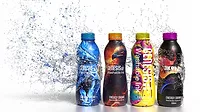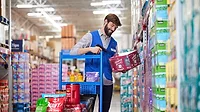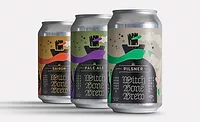Glass Packaging
Glass beverage packaging draws consumers with sustainability, sophistication appeal
The infinitely recyclable packaging material attracts consumers and brands alike

Image courtesy of Glass Packaging Institute
In the 1978 song “Heart of Glass,” popstar Blondie tells of a tumultuous relationship. “Once I had a love and it was a gas / Soon turned out had a heart of glass / Seemed like the real thing, only to find / Much mistrust, love’s gone behind,” she sings.
Although the song is about a fragile romantic state, the demand for glass packaging in the beverage market isn’t as fragile and instead remains strong.
Ronald Holmes, vice president of sales, marketing and sustainability at Valdosta, GA-based Arglass, describes it as such.
“Glass is the preferred packaging for the spirits industry, and provides the premium and sustainable characteristics that beverage brands seek in their packaging material,” he says. “Additionally, we are seeing greater demand for domestic glass container manufacturers as the overseas markets experience more uncertainty and higher shipping costs.”
In response to these trends and to accommodate increased demand, Holmes shares that the company is expanding its facility in Valdosta with the implementation of a second glass furnace and production line.
The experts at Oakbrook Terrace, IL-based TricorBraun express comparable thoughts.
“We have seen steady growth in the glass market, mostly due to the increased demand for environmentally friendly packaging,” says Jon Zuckerman, vice president of operations at TricorBraun’s Zuckerman Honickman.
Becky Donner, senior vice president of marketing, design and engineering at TricorBraun also feels that the demand for glass packaging in the beverage market is increasing steadily, especially “due to perceived premium quality and ability to preserve the flavor and freshness of beverages.” She adds that health-conscious consumers tend to prefer glass packaging, and that the emergence of premium teas as an alternative to coffee has contributed to glass packaging’s popularity.
Sustainability also is impacting the demand for glass packaging.
“Consumers are more eco-conscious than ever before,” Zuckerman says. “Because glass is infinitely recyclable, and also reusable, people see it as a sustainable choice.”
Arglass’ Holmes states that consumers are choosing to purchase products from companies that prioritize sustainability.
“As brand owners adapt to meet evolving consumer needs, they are finding that glass packaging can help them to achieve their sustainability goals,” he says. “As the only infinitely recyclable packaging material, glass packaging overcomes the challenges of ‘single use’ containers, appealing to eco-conscious consumers and driving demand for highly sustainable glass packaging among beverage brands.”
To support recycling efforts, players in the glass market must get involved. Holmes says that recycling plays a key role in glass container manufacturing — noting “every glass container recycled is a glass container made.”
“At Arglass, we are invested in recycling through our partnership with the Upcycling Company to recover millions of glass containers from consumers throughout the Southeast for processing at our on-site recycling plant, diverting waste from landfills, securing a steady supply of cullet for production, and leading the industry forward with advancements in circularity,” he explains.
Arglass recycles its own materials, Holmes adds, and any products that are pulled from the line due to imperfections are broken down and reused.
TricorBraun’s Donner says that the focus on sustainability increases the demand for glass packaging because it is infinitely recyclable without losing its quality. She says that consumers might not understand the energy required to fire up a furnace or the added cost to transport glass due to its weight.
“Consumers have ‘some’ information about glass being more sustainable and they look at glass as an eco-friendly packaging option,” she adds.
Rachel Murphy, director of category and consumer insights at TricorBraun, echoes similar thoughts regarding the sustainability benefits of glass.
“However, a lot of factors play into how sustainable a package is, such as where it’s manufactured, shipment weight and distance, how likely breakage of a product is, how easy the material is able to be recycled, etc.,” she says. “Lightweighting glass continues to be a strong option for improving its carbon footprint.”
Zuckerman Honickman’s Zuckerman says that there has been an increase in strategic alliances between recyclers and manufacturers to foster innovation and market growth in the recycled glass industry.
“Additionally, improved recycling technology has helped to drive efficiency and quality in recycled glass production,” he notes.
Scott DeFife, president of the Glass Packaging Institute (GPI), Arlington, VA, says the demand for glass packaging in the beverage industry is resilient and ever evolving.
“Glass packaging offers a unique combination of benefits that resonate with consumers and businesses alike,” he states. “Its unparalleled ability to preserve the taste, freshness and quality of beverages makes it the preferred choice for a wide array of products, ranging from premium spirits to artisanal juices. Additionally, glass is inert and impermeable, ensuring that the integrity of the contents remains intact without any risk of contamination.”
DeFife explores the way sustainability has influenced the demand for glass packaging. Aside from the way it aligns with a circular economy, the way glass is produced also is sustainable.
“Furthermore, glass is made from abundant, locally sourced, natural, raw materials such as sand, soda ash and limestone, making it a renewable and sustainable choice compared to materials derived from fossil fuels or other scarce resources with higher environmental impact in other parts of the world,” he explains. “Consumers view sustainability through several lenses that preference glass — with no toxics concerns, no marine or environmental impact for mismanaged waste, and no use of plastic components or liners that require chemicals.”
He shares that one of the primary efforts made by players in the glass market is to promote and invest in recycling infrastructure, including collaborating with municipalities and recycling facilities “to enhance collection, sorting and processing capabilities for glass materials.”
“Education and awareness campaigns play a crucial role in encouraging recycling behavior among consumers,” DeFife says. “Glass packaging manufacturers, along with industry associations like the Glass Packaging Institute, actively engage in educational initiatives to inform consumers about the importance of recycling glass and how to properly sort and dispose of glass waste.”
Beyond sustainability
Other factors and trends are contributing to the use of glass packaging in the beverage industry.
TricorBraun’s Murphy says that consumers continue to be very price-conscious.
“Cost, in addition to taste and wellness benefits, are driving buying behavior over sustainability in this category,” she notes. “Therefore, if the total package doesn’t communicate the benefits of the product to the consumer, the consumer is most likely to make a decision based on price.”
Murphy’s colleague Donner says that additional factors are the rise of premium and artisanal beverages, the growing popularity of functional and health-focused drinks, as well as the increasing demand for convenient single-serve options.
“The fact that glass is transparent means consumers can see the product, which further boosts the appeal of glass, especially for beverages with vibrant colors or unique visual characteristics,” Donner adds. “Also, there is a rise in the number of ‘boutique/niche’ beverage brands.”
 Experts share that glass packaging continues to be preferred packaging method for spirits category. Image courtesy of Arglass
Experts share that glass packaging continues to be preferred packaging method for spirits category. Image courtesy of Arglass
Beyond sustainability, the benefits of glass packaging has prompted consumers to want to see more products in glass packaging, GPI’s DeFife says.
“Glass is the healthy choice for packaging because it is nonporous, impermeable, non-toxic and has an almost zero rate of chemical interactions,” he explains. “Thus, glass does not have any kind of adverse impact on the product’s flavor, quality, purity or makeup.”
As new and emerging beverage sectors mature, DeFife expects to see more differentiation among packaging choices. As some brands approach premiumization, he suggests there will be more glass usage.
“Premiumization is a significant trend that has been driving the demand for glass packaging,” DeFife says. “Consumers are increasingly seeking high-quality, premium beverages. … Glass packaging is inherently associated with quality and sophistication, making it the preferred choice for brands looking to convey a sense of luxury and distinction. The aesthetic appeal and premium feel of glass bottles contribute to the overall brand image and enhance the perceived value of the product.”
Going for glass
Many categories are embracing glass packaging. Yet, Arglass’ Holmes notes that it tends to be the preferred packaging of the spirits industry.
“Additionally, we are seeing more inquiries from the non-alcohol beverage industry exploring glass to help reach new customers with premium glass packaging,” he says.
TricorBraun’s Murphy shares that, due to its weight, glass is perceived as premium to consumers.
“Therefore, we see glass packaging increasingly embraced for brands that want to resonate as such,” she says. “We see mocktails increasingly launched in glass to rival their alcoholic counterparts. In addition, premium RTD (ready-to-drink) teas and coffees.”
Recently, Owens-Illinois General Inc. (O-I), Perrysburg, Ohio, launched an RTD glass drinktainer. Along with F.X. Matt and Right Coast Spirits, Right Coast Spirits are the first to enter the market in the Drinktainer.
Lemon Vodka Freeze and Cherry Vodka Chill hit shelves in April, packaged in 375-ml four packs.
“The sensory experience of Drinktainer, paired with the invigorating real fruit and vodka flavors in Right Coast Spirits’ Italian Ice line, promises a superior drinking experience versus the current RTD offerings on the market,” said Sarah Brennan, North American marketing and NPD director for O-I, in a statement. “By working with our co-packing partner, F.X. Matt, the speed-to-market of Drinktainer will ensure this unique experience is on shelves just as weather is starting to warm up.”’
GPI’s DeFife explains that many beverage categories are embracing glass packaging. Like Murphy, he notes that the alcohol beverages sector is the most prominent to do so.
“Wines, beers, spirits and liqueurs, glass bottles are synonymous with quality and sophistication in the world of alcohol,” DeFife expresses. “The transparency, elegance and premium feel of glass packaging enhance the perceived value of these beverages, making them stand out on store shelves and appealing to discerning consumers.”
He says that non-alcohol beverages also are increasingly favoring glass packaging.
“Natural and organic beverages, such as cold-pressed juiced, kombuchas, health-focused teas and sparkling waters are often packaged in glass bottles or jars,” DeFife observes.
As for what is on the horizon for glass packaging, DeFife stresses the ongoing focus on sustainability.
“However, we’re constantly striving to make improvements throughout the entire lifecycle of glass packaging,” he says. “This includes efforts to optimize recycling infrastructure, reduce energy consumption in manufacturing, and explore innovative ways to source raw materials more sustainably.”
He also suspects that customization and personalization are becoming increasingly important trends, and glass can help brands achieve them.
“Brands are seeking unique and memorable packaging solutions that help them stand out on crowded store shelves and resonate with consumers on a deeper level,” DeFife says. “Glass packaging offers endless possibilities for creative design, customization and branding, allowing brands to tell their story and connect with customers in a more authentic and impactful way.”
TricorBraun’s Murphy echoes such thoughts.
“We expect to see continued lightweighting of glass options and the use of glass for premium options,” she says. “Enhanced decoration through shape, texture and decoration will appeal for premiumization.”
Murphy adds that glass will be a preferred material for new launches in premium, non-alcohol formats.
Arglass’ Holmes shares that the future of glass packaging is reliant on more companies lowering their carbon footprint.
“Glass is highly sustainable, but it is the responsibility of manufacturers to invest in sustainable processes for raw materials sourcing and glass container manufacturing,” he says. “… For packaging in general, we are proud to be leading the industry forward with sustainability advancements, including solar power generation, hydrogen-ready glass furnaces and closed-loop production, as well as fully automated quality assurance processes strengthened by the implementation of advanced sensors and AI (artificial intelligence).”
Looking for a reprint of this article?
From high-res PDFs to custom plaques, order your copy today!







